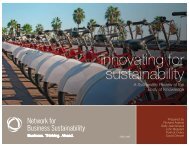embedding sustainability in organizational culture - Network for ...
embedding sustainability in organizational culture - Network for ...
embedding sustainability in organizational culture - Network for ...
Create successful ePaper yourself
Turn your PDF publications into a flip-book with our unique Google optimized e-Paper software.
Chapter 1: 5: Introduction Build<strong>in</strong>g Momentum <strong>for</strong> Change<br />
42<br />
concludes that that key to <strong>embedd<strong>in</strong>g</strong> Bank of America’s <strong>in</strong>novation <strong>culture</strong> was the<br />
commitment of and leadership by the CEO and top 100 executives. Benson and Ross<br />
(1998) found that the appo<strong>in</strong>tment of a known and respected champion to manage<br />
the firm’s ethics program is essential <strong>for</strong> <strong>embedd<strong>in</strong>g</strong> a <strong>culture</strong> of ethical conduct.<br />
The research reviewed here provides support <strong>for</strong> the effectiveness of champion<strong>in</strong>g<br />
and also provides <strong>in</strong>sight <strong>in</strong>to successful champion<strong>in</strong>g tactics.<br />
assessment: Supported<br />
<strong>in</strong>vite<br />
The practices <strong>in</strong> this category reflect attempts to solicit and be receptive to ideas and<br />
<strong>in</strong>put from employees and others outside of the organization. These practices range<br />
from <strong>in</strong>vit<strong>in</strong>g <strong>in</strong>put, to show<strong>in</strong>g genu<strong>in</strong>e <strong>in</strong>terest <strong>in</strong> employees’ op<strong>in</strong>ions and ideas<br />
to be<strong>in</strong>g attentive to their suggestions and recommendations. The practices <strong>in</strong> this<br />
category are ask<strong>in</strong>g; listen<strong>in</strong>g; and seek<strong>in</strong>g external help.<br />
aSk: proactively seek op<strong>in</strong>ions and ideas about how to grapple with<br />
<strong>susta<strong>in</strong>ability</strong> issues<br />
• Encourage dialogue and questions<br />
• Hold staff meet<strong>in</strong>gs to generate ideas on <strong>susta<strong>in</strong>ability</strong><br />
• Request feedback from <strong>in</strong>ternal and external stakeholders<br />
• Br<strong>in</strong>g <strong>in</strong> external consultants to hold employee feedback sessions<br />
• Allow anonymous feedback (suggestion boxes or onl<strong>in</strong>e<br />
mechanisms)<br />
• Ask open-ended questions to generate talk about change<br />
• Ask employees how they would like to improve <strong>susta<strong>in</strong>ability</strong> <strong>in</strong> an<br />
ideal world<br />
• Ask employees if they are proud of their organization<br />
As an organization develops and changes, employee and other stakeholder feedback<br />
becomes a vital feedstock <strong>for</strong> the <strong>in</strong>novation process. There are many ways to<br />
proactively garner feedback: host staff meet<strong>in</strong>gs; conduct surveys; or create<br />
suggestion boxes. Employees and other stakeholders can be prompted to voice<br />
their op<strong>in</strong>ions on the organization’s strategy; suggest new and creative ideas and<br />
solutions; and jo<strong>in</strong> open discussions about <strong>susta<strong>in</strong>ability</strong> issues. The <strong>Network</strong> <strong>for</strong><br />
Bus<strong>in</strong>ess Susta<strong>in</strong>ability (2010) recommends creat<strong>in</strong>g a safe place <strong>for</strong> bold ideas to<br />
emerge. Organizations can ask employees how they want the organization to be<br />
perceived by others (Doppelt, 2008).<br />
One company’s motto “don’t waste your time worry<strong>in</strong>g about someth<strong>in</strong>g, say it”,<br />
prompts employees to volunteer their feel<strong>in</strong>gs about the organization (Angel del Brio<br />
et al., 2008). An <strong>in</strong>terviewee <strong>in</strong> Bowen’s (2004) study said that everyone’s op<strong>in</strong>ion<br />
counted and that feedback from employees was expected by senior management.<br />
One organization <strong>in</strong>tegrates <strong>susta<strong>in</strong>ability</strong> <strong>in</strong>to their <strong>culture</strong> by hold<strong>in</strong>g quarterly<br />
meet<strong>in</strong>gs at which they address core values and encourage employees to voice their<br />
op<strong>in</strong>ion about the organization’s bus<strong>in</strong>ess and vision (Molnar & Mulvihill, 2003).<br />
The anecdotes raised <strong>in</strong> the research reviewed here po<strong>in</strong>t to the potential importance<br />
of the senior leadership solicit<strong>in</strong>g op<strong>in</strong>ions so that employees ‘feel heard.’ Further<br />
research could explore whether (and how) solicit<strong>in</strong>g employee <strong>in</strong>put contributes to<br />
<strong>embedd<strong>in</strong>g</strong> <strong>susta<strong>in</strong>ability</strong>.<br />
assessment: Weakly supported<br />
liStEn: Be receptive or open to op<strong>in</strong>ions and new ideas about <strong>susta<strong>in</strong>ability</strong><br />
• Provide opportunities <strong>for</strong> employees to speak to senior management<br />
• Listen more and talk less<br />
When attempt<strong>in</strong>g to br<strong>in</strong>g about change, organizations often make use of the<br />
proactive behaviours already described <strong>in</strong> this chapter. But while it is important<br />
to raise awareness, champion and even solicit op<strong>in</strong>ions by ask<strong>in</strong>g, it is equally<br />
important to listen. Some of the best corporate responsibility programs are<br />
based on <strong>in</strong>put from employees <strong>in</strong> operational departments; these employees<br />
are ideally situated to make recommendations on mak<strong>in</strong>g systems and processes<br />
more susta<strong>in</strong>able if senior management is will<strong>in</strong>g to listen (Ethical Corporation,<br />
2009). In fact, employees may f<strong>in</strong>d the ear of senior management just as reward<strong>in</strong>g<br />
as monetary <strong>in</strong>centives (NBS, 2010). Willard (2009) suggests that listen<strong>in</strong>g to<br />
employee helps them to feel valued and helps to create shared mean<strong>in</strong>gs.<br />
There is some prelim<strong>in</strong>ary support <strong>for</strong> the value of listen<strong>in</strong>g. In Bansal’s (2003)<br />
study on corporate responses to environmental issues, senior management’s<br />
will<strong>in</strong>gness to listen was a factor <strong>in</strong> further<strong>in</strong>g the <strong>susta<strong>in</strong>ability</strong> agenda. Clarke<br />
and Roome (1999) found that corporate effectiveness <strong>in</strong> develop<strong>in</strong>g responses<br />
to environmental concerns and susta<strong>in</strong>able development was <strong>in</strong>fluenced by an<br />
organization’s will<strong>in</strong>gness to listen to stakeholders.
















